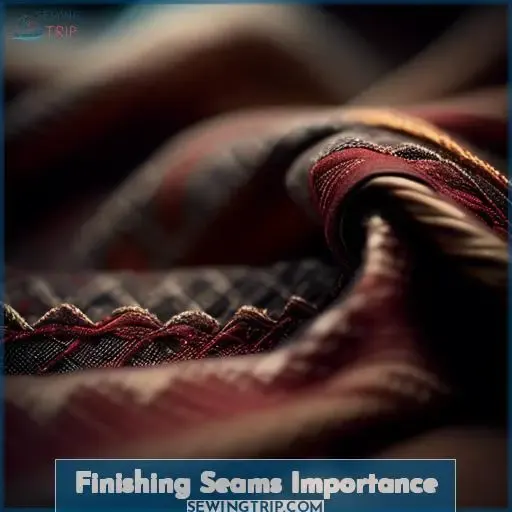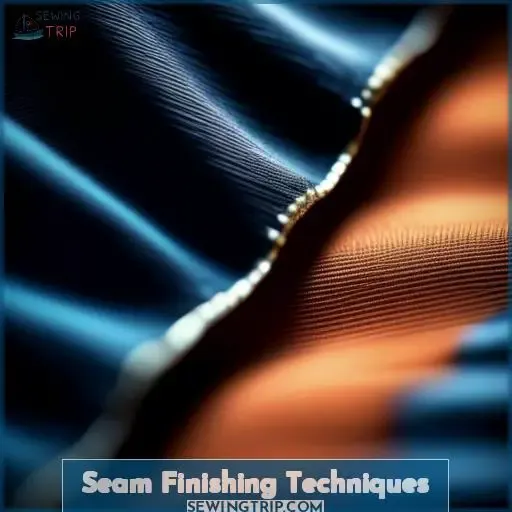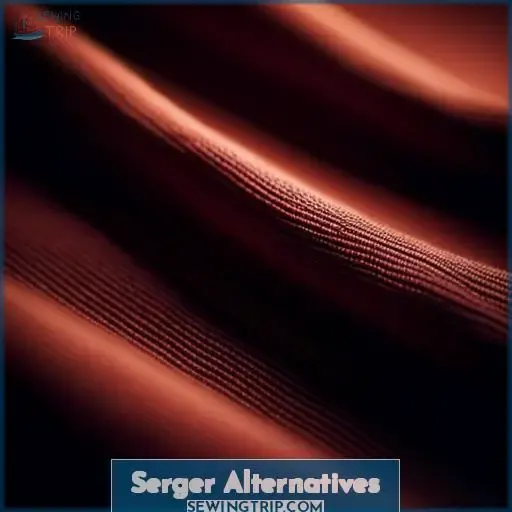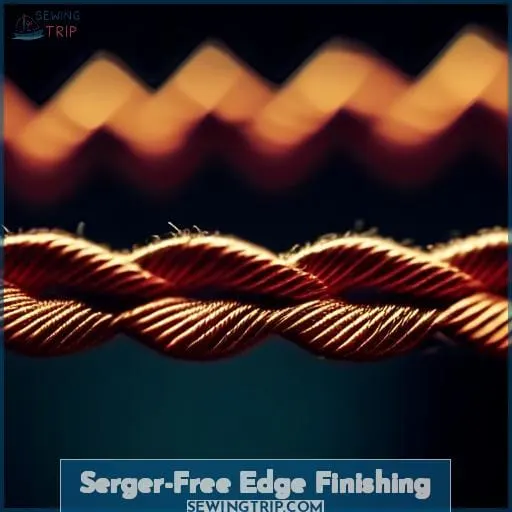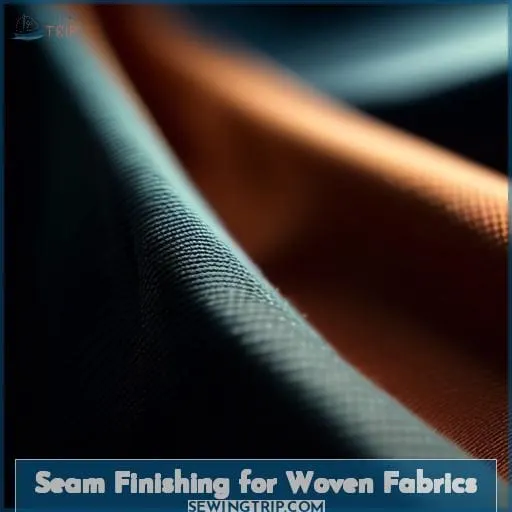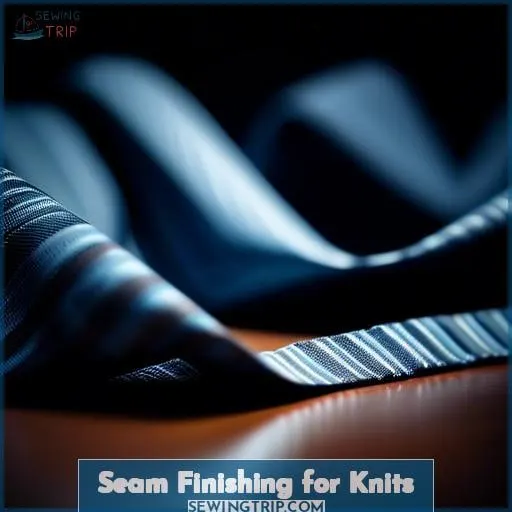This site is supported by our readers. We may earn a commission, at no cost to you, if you purchase through links.
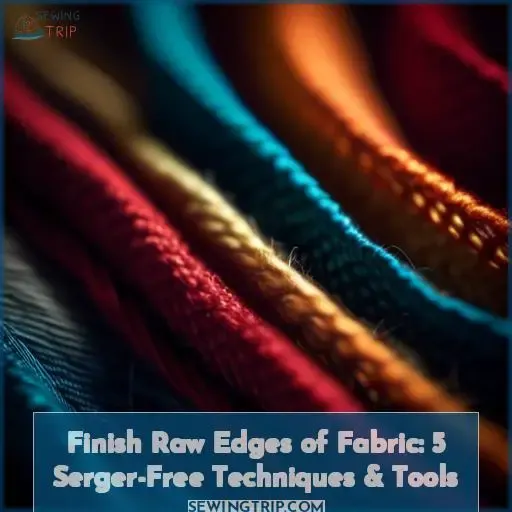 Frayed fabrics can quickly fray your nerves, but fear not! You don’t need a serger to finish raw edges of fabric with finesse.
Frayed fabrics can quickly fray your nerves, but fear not! You don’t need a serger to finish raw edges of fabric with finesse.
Dive into the world of serger-free techniques that promise to keep your projects from unraveling at the seams. Whether you’re a seasoned stitcher or a sewing novice, these five methods and essential tools will transform your creations, ensuring durability and adding a touch of professionalism.
From pinking shears to zigzag stitches, let’s explore how to achieve that coveted clean finish, no serger required.
Table Of Contents
Key Takeaways
- Pinking shears provide a quick and simple method for finishing seams, especially suitable for fabrics that do not fray easily, making them a practical choice for projects that are not frequently washed or are made from tightly woven materials.
- Zigzag stitches offer a versatile and commonly used alternative for finishing seams on a variety of fabrics, including those that are thick or bulky, and can be applied by sewing along the edge of the seam allowance to prevent fraying.
- French seams present a neat and durable option for finishing seams, particularly effective for light and sheer fabrics, as they fully encase the raw edges within the seam itself, thereby preventing fraying and offering a clean finish inside the garment.
- The use of hem tape and the YEQIN Overlock Vertical Presser Foot are innovative no-sew and sewing solutions, respectively, for hemming and finishing seams without a serger, providing quick and easy methods to achieve a clean and professional look on various projects.
Finishing Seams Importance
Finishing seams is crucial in sewing to prevent the fabric from fraying and to add strength to the seams.
You don’t need a serger to achieve neat and durable edges; there are several techniques and tools that can help you finish seams effectively.
Pinking shears, zigzag stitches, and hem tape are just a few options that can provide a professional look to your sewing projects without the need for specialized equipment.
Prevents Fraying
Finishing seams is crucial in sewing to prevent fraying and to strengthen the seams of your fabric projects.
While a serger, also known as an overlock machine, is often used for this purpose, it’s not the only method available. You can achieve clean, fray-resistant edges using serger techniques with tools like pinking shears, which create pinked seams with a zigzag pattern that inhibits fraying.
Alternatively, an overcast presser foot can be used with a sewing machine to produce an overlock-like finish. Machine overcast stitches mimic serger thread wraps, securing the fabric edges neatly.
These methods aren’t only practical but also adaptable to different types of fabrics and projects, ensuring your creations are both durable and professionally finished without the need for a serger.
Strengthens Seams
Finishing seams isn’t just about preventing fraying; it’s also crucial for enhancing the overall durability and quality of your sewing projects. By focusing on seam durability and stitch strength, you ensure that your garments and fabric projects withstand wear and tear over time.
Techniques like French seams, Hong Kong or bound seams, and turned under edges contribute significantly to this goal. French seams, for instance, encase the raw edges within the seam itself, offering a clean finish that’s as strong as it’s aesthetically pleasing, especially for lightweight fabrics.
Hong Kong or bound seams, on the other hand, involve binding the seam allowances with bias tape, providing both fabric protection and a touch of elegance to the insides of unlined garments. These methods, along with others like the overcast folded seam, not only prevent unraveling but also elevate the seam quality, ensuring your creations look professional and last longer.
Seam Finishing Techniques
When you’re looking to finish the raw edges of your fabric without a serger, you have several techniques at your disposal.
You can use pinked seams for a quick and simple finish, especially on fabrics that don’t fray easily.
For a more durable edge, zigzag seams can be applied, which are effective on a variety of fabric types and prevent fraying by locking the raw edges.
If you’re working with lightweight fabrics, the turn and stitch method provides a neat finish by folding the raw edge under and stitching it down.
Machine overcast stitches mimic the effect of a serger and can be used with an overcast presser foot to wrap thread around the fabric edge.
Lastly, Hong Kong or bound seams offer a clean and refined finish by encasing the seam allowances with binding, suitable for unlined jackets or garments where the inside is visible.
Each method has its own advantages and can be chosen based on the fabric type and the desired durability and appearance of the finished project.
Pinked Seams
Pinked seams offer a serger-free finish that’s both practical and adaptable, especially for those without access to a serger.
By using pinking shears, a tool that creates a zigzag or razor blade finish along the raw edges of fabric, you can effectively prevent fraying. This method is particularly useful for woven fabrics with a tight weave, though it’s less recommended for fabrics that are washed frequently due to potential fraying over time.
For added durability, you can complement pinked seams with other techniques such as zigzag seams or applying bias tape, enhancing the strength and neatness of your project.
This approach to finishing seams without a serger showcases innovation and a desire for quality in sewing practices.
ZigZag Seams
Zigzag stitches offer a versatile solution to finish raw edges of fabric without a serger. Adjust your machine to a zigzag stitch with a length of 2.4-2.5mm and a width of 3-3.
Use an overedge, overcast, or overlock foot for precision. This technique strengthens seams, prevents fraying, and is suitable for sewing beginners.
Turn & Stitch
Turn & Stitch is a classic seam finishing technique that’s both functional and visually appealing.
- Begin by sewing your seam as usual.
- Trim the seam allowance to about 7mm (1/4in).
- Fold the raw edge of the seam allowance under to the line of stitching and press.
- Stitch close to the folded edge to secure it in place.
- Press the seam again to ensure a crisp finish.
This method is particularly effective for woven fabrics and can be used on both straight and curved seams. It’s a great alternative to serging, providing a neat finish that helps prevent fraying and adds strength to the seam.
For added durability, especially on knit fabrics or areas subject to stress, you might consider reinforcing with hem tape or bias bound edges. Remember, the key to a professional-looking turn and stitch is precision in folding and stitching, so take your time to ensure straight and even lines.
Machine Overcast
Finish raw edges of fabric without a serger using machine overcast, a versatile technique for seam finishes.
Adjust your sewing machine settings to a zigzag stitch with a stitch length of 2.
Prepare your seams by stitching as usual and trimming allowances to 7mm.
Use an overcasting presser foot for fabric compatibility, ensuring edges stay aligned.
This method strengthens seams and prevents fraying, offering a neat, serger-like finish without the need for a serger.
Hong Kong Seams
Hong Kong seams elevate your sewing projects by wrapping bias tape around seam allowances, creating bound edges that are both elegant and durable.
This technique, perfect for medium to heavy fabrics, involves sewing the bias tape to the seam allowance, then folding it over and securing it with a blind stitch for a neat finish.
While it doesn’t require a serger machine, using an overlock foot can help achieve precise stitching.
Ideal for unlined jackets or dresses, Hong Kong seams add a touch of luxury, making your garments look professionally finished inside and out.
Tools for Seam Finishing
When it comes to giving your sewing projects a professional and durable finish, even without a serger, there are several tools at your disposal.
Pinking shears, hem tape, and an overlock foot can all be used to prevent fabric edges from fraying and to strengthen seams. These tools offer practical solutions for enhancing the neatness and longevity of your projects, ensuring that your creations look polished and withstand wear and tear over time.
Pinking Shears
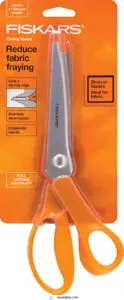
Pinking shears are a must-have in your sewing toolkit, especially when you’re looking to finish fabric edges without a serger. These special scissors create a zigzag pattern that not only adds a decorative touch but also plays a crucial role in preventing fraying.
Ideal for light to medium-weight woven fabrics, they can handle even heavy materials like denim with ease. Whether you’re finishing seams, reducing bulk in seam allowances, or crafting decorative elements, pinking shears offer a quick and effective solution.
Their unique design cuts fabric along the bias grain, making it harder for threads to unravel. This technique is particularly effective on tightly woven fabrics that aren’t frequently washed, ensuring your projects stay neat and durable over time.
- Prevents fraying by cutting fabric in a zigzag pattern.
- Versatile for a variety of projects, including seam finishing and decorative edges.
- Suitable for light to heavy-weight woven fabrics.
- Not effective on knit fabrics or for cutting pattern pieces.
- May still allow minimal fraying on loosely woven fabrics.
- Requires alignment of teeth for a clean cut, which can be challenging.
Hem Tape
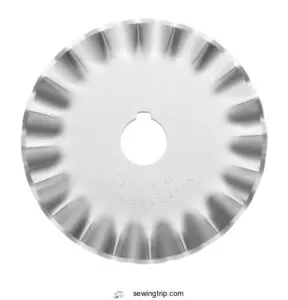 View On Amazon
View On Amazon
Hem tape is a game-changer for those looking to achieve a neat and durable hem without the need for sewing. This double-sided adhesive strip is designed to fuse two layers of fabric together, offering a quick and easy solution for hemming garments or making repairs.
It’s particularly useful for on-the-go adjustments or when you’re in a hurry and need a permanent fix. Available in various widths and strengths, hem tape caters to different fabric types and hem sizes, ensuring a seamless match for your project.
Whether you’re working with lightweight fabrics like silk or heavier materials such as denim, selecting the right type of hem tape is crucial for achieving the best results. It’s also available in different colors, allowing for a discreet application that blends with your fabric.
For a quick hem or repair, hem tape is an invaluable tool in your crafting arsenal, providing a no-sew solution that’s both convenient and effective.
- Quick and easy to use, providing a no-sew solution for hems and repairs.
- Suitable for a wide range of fabric types and weights.
- Available in various widths and colors to match different projects.
- Not suitable for all fabric types, particularly very smooth or sticky surfaces.
- May require additional stitches for thicker fabrics to ensure a durable bond.
- Can come off in the dryer, though it can be reapplied for a better hold.
Overlock Foot
After discussing hem tape as a means to finish fabric edges, let’s turn to the overlock foot, a serger alternative that can help you achieve a clean seam finish.
This tool is designed to prevent fabric fraying and to manage raw edges effectively. When you attach an overlock foot to your sewing machine, it guides the fabric so that the needle can wrap stitches around the edge, mimicking the effect of a serger.
This is particularly useful for woven fabrics where fraying can be an issue. The overlock foot often has a bar that keeps the fabric flat, allowing for a neat, serged look without the need for a serger machine.
Serger Alternatives
When it comes to finishing the raw edges of fabric without a serger, you’re not limited in your options.
French seams, folded zigzag, and straight stitch are three effective techniques that can give your sewing projects a polished look. These methods are adaptable to various types of fabrics and project requirements, ensuring durability and preventing fraying.
Whether you’re working with delicate fabrics or constructing everyday garments, mastering these serger-free seam finishes can elevate the quality of your work.
French Seams
French seams offer a neat and durable finish, perfect for light and sheer fabrics that fray easily.
To create French seams:
- Sew your fabric wrong sides together with a straight stitch.
- Trim and press the seam allowance.
- Fold the fabric right sides together, encasing the raw edge, and stitch again.
Adjust your thread tension and stitch length to suit the types of fabric you’re working with.
Folded Zigzag
After mastering French seams, you can also explore folded zigzag as one of the alternatives to serger for neatening fabric edges.
This sewing technique involves a zigzag stitch to prevent fraying. Set your machine to a zigzag stitch with a recommended length of 2.
Align the fabric edge with the guide on your overcast foot, if available, to ensure precision.
This method is adaptable for various fabric types and enhances the durability of your seams.
Straight Stitch
To finish seams with a straight stitch, you’ll need to consider the fabric type, seam allowance, needle size, and thread tension.
- Choose the correct needle size for your fabric to prevent puckering or skipped stitches.
- Adjust the thread tension to ensure the stitches are neither too tight nor too loose.
- Sew a straight stitch inside the seam allowance to secure the fabric edge and prevent fraying.
Top 5 Best Seam Finishes
When it comes to finishing the raw edges of fabric without a serger, there are several effective techniques and tools that can help achieve a neat and professional look.
Among the top options are the YEQIN Overlock Vertical Presser Foot, Fabric Fusing Hem Tape White, Singer M662 Sewing Machine, Green Pinking Shears Comfort Grips, and the Snap-on Overcast Presser Foot Honeysew.
These methods offer a range of solutions for different fabric types and project needs, ensuring durability and preventing fraying with or without the use of a serger.
3. YEQIN Overlock Vertical Presser Foot
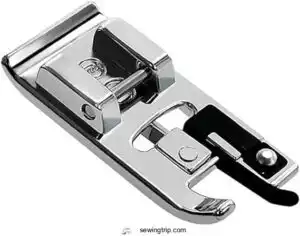 View On Amazon
View On Amazon
The YEQIN Overlock Vertical Presser Foot is your ally in achieving professional-looking edges without a serger. It’s designed to fit all low shank snap-on machines, including many popular brands. This high-quality foot helps prevent fraying and gives your sewing projects a clean, finished look.
It’s straightforward to use, enhancing your sewing experience. While the metal side guide is sturdy enough, some users may need to file it to avoid thread catching, ensuring smoother operation.
- Compatible with a wide range of low shank sewing machines
- Prevents fabric edges from fraying, enhancing the finish
- High-quality and user-friendly for a professional edge
- Metal side guide may require filing for optimal thread flow
- Some users found the guide not as solid as expected
- May not fit all machines without an adaptor
4. Fabric Fusing Hem Tape White
For a quick, no-sew solution to hemming, fabric fusing hem tape is your go-to. It’s a solid adhesive that, when heated, bonds fabric layers, ideal for various textiles.
Hem tape alternatives like fusible webbing offer a lighter finish, but hem tapes add structure, affecting drape.
Store hem tapes properly to maintain their adhesives.
7. Singer M1000.662 Sewing Machine
The SINGER M1000.662 sewing machine is your go-to for basic mending and light sewing projects. Weighing just 5.5 pounds, it’s a breeze to take along for sewing classes or quick repairs. With 32 stitch applications, you’ll have the right stitch for a variety of tasks.
Its ease of use makes it ideal for beginners, featuring a top drop-in bobbin, preset stitch length and width, and a finger guard for safety. Plus, it’s compact enough to fit in small spaces, perfect for those starting out or needing a secondary machine for simple tasks.
- Lightweight and portable, ideal for on-the-go sewing
- 32 stitch applications for versatility in mending and light sewing
- Easy stitch selection and threading for beginners
- Not suitable for heavy-duty sewing or thick fabrics
- Limited stitch length adjustment may restrict some projects
- Some users report issues with bobbin threading and stitch quality
9. Green Pinking Shears Comfort Grips
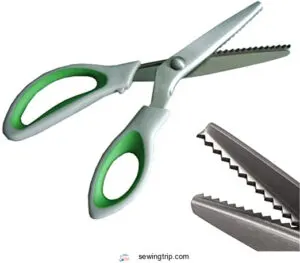
When tackling your next sewing project, don’t overlook the JISTL Green Pinking Shears. These shears are a game-changer for preventing fabric fraying, ensuring your creations look polished and last longer.
With their sharp, stainless steel blades and comfortable grip, you’ll find cutting through various materials a breeze. Whether you’re working on a delicate silk scarf or a sturdy leather bag, these pinking shears can handle it, making them an essential tool in your sewing kit.
- Cuts smoothly and cleanly
- Comfortable handle and good length
- Adjustable for different materials
- Struggles with thick fabric or leather
- Limited to a few layers of flannel at a time
10. Snap on Overcast Presser Foot Honeysew
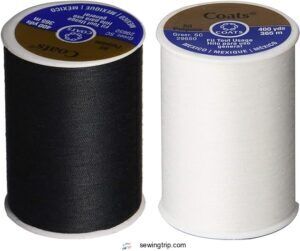 View On Amazon
View On Amazon
The Snap on Overcast Presser Foot Honeysew is a versatile tool that allows you to finish raw edges with a professional touch, even without a serger. It’s designed to prevent fraying by wrapping thread around fabric edges, fitting various Babylock sewing machine models.
With dimensions of 3.78 x 2.68 x 0.28 inches and a weight of 0.317 ounces, this presser foot is a practical addition to your sewing kit. Its compatibility with low shank machines makes it a go-to for many sewing enthusiasts.
- Prevents fraying and unraveling of fabric edges
- Compatible with a range of Babylock sewing machine models
- Lightweight and easy to use for a professional finish
- May require an adapter for non-compatible machines
- Some users report needing to file the foot to prevent thread catching
- Not as robust as a serger, which also trims the fabric edges
Serger-Free Edge Finishing
When it comes to finishing the raw edges of your fabric without a serger, you have several practical options at your disposal.
You can use pinking shears to create a zigzag pattern that reduces fraying, especially on fabrics that aren’t washed frequently.
Alternatively, a zigzag stitch with your sewing machine can secure the edges more effectively for items that will be laundered, although it’s a bit more labor-intensive than using pinking shears.
Both methods are beginner-friendly and can help your sewing projects look neater and last longer.
Pinking Shears Method
Pinking shears offer a simple yet effective technique for preventing fabric fraying, especially when you don’t have access to a serger. These scissors, equipped with a serrated blade, create a zigzag pattern along the edge of the fabric.
This pattern minimizes the risk of the threads unraveling, acting as a zigzag stitch alternative. Ideal for crafts, pinking shears not only prevent fraying but also add a decorative touch to your projects.
When using them, ensure your fabric is laid flat and cut in a consistent motion to achieve a neat, zigzagged edge. This method is particularly useful for light to medium weight woven fabrics, offering a quick and easy solution to enhance the durability of your sewing creations.
Zigzag Stitch Method
To finish raw edges without a serger, the zigzag stitch method is a practical and adaptable technique that can be applied to various fabric types.
When setting up your sewing machine, adjust the zigzag stitch length to about 2.4-2.5mm and the stitch width to 3-3.5mm for optimal results. These settings help prevent fraying and add strength to the seams.
The type of thread you choose should be compatible with your fabric to ensure durability and a clean finish.
As you stitch, ensure the fabric edges are aligned with the guide on your presser foot, and backtack or tie off loose threads to secure the seam.
Remember to press the seams afterward to enhance the neatness of your project.
Seam Finishing for Woven Fabrics
When finishing seams for woven fabrics, you’re aiming for durability and fabric protection, ensuring the longevity of your garment. The right thread selection and stitch strength are crucial for maintaining edge neatness and preventing fraying.
For woven fabrics, consider using a zigzag stitch, which is a versatile option that can handle different fabric weights. Set your sewing machine to a stitch length of 2.4-2.5mm and a width of 3-3.5mm. This setting will help secure the fabric edges, reducing the risk of fraying.
Another reliable method is the turn and stitch technique, which involves folding the raw edge of the seam allowance and stitching it down.
Machine overcasting, also known as overedge or overlock stitch, can mimic the effect of a serger. Most modern sewing machines come with this function, allowing you to finish seams neatly without the need for a serger.
For those who prefer not to sew, iron-on hem tape offers a no-sew option that can seal fabric edges with heat-activated adhesive. However, this method may not be as durable as sewing and is better suited for projects that won’t undergo frequent washing or heavy use.
Seam Finishing for Knits
Transitioning from the meticulous world of woven fabrics, we now delve into the realm of knits—a territory where the rules of engagement shift to accommodate the unique characteristics of these stretchy materials.
Knit fabrics, celebrated for their flexibility and comfort, demand a tailored approach to seam finishing that respects their inherent stretch and softness. Understanding the fabric’s behavior is crucial as it influences the choice of seam sewing techniques, thread selection, and machine settings.
Knit fabrics are inherently different from wovens; they’re constructed from interlocking loops of yarn, making them stretchy, soft, and somewhat resistant to fraying. However, this doesn’t mean the raw edges of knit fabrics should be neglected. Proper seam finishing can enhance the garment’s durability, appearance, and comfort.
When working with knits, it’s essential to select a seam finish that allows the fabric to retain its stretch without compromising the seam’s integrity.
For seam sewing on knits, the use of stretch stitches, such as the zigzag stitch or the stretch stitch (often resembling a lightning bolt), is recommended. These stitches provide the necessary elasticity, ensuring that the seams can stretch with the fabric without breaking.
Thread selection also plays a pivotal role; polyester threads or wooly nylon threads are preferred for their strength and elasticity. Adjusting machine settings to accommodate the fabric’s stretch is another critical step; a narrower zigzag stitch or a specific stretch stitch setting can prevent seam puckering and allow the fabric to stretch comfortably.
In summary, when finishing seams on knit fabrics, it’s vital to consider the fabric’s characteristics, opting for stretch stitches, appropriate thread types, and adjusted machine settings. This approach ensures that the finished garment isn’t only durable and comfortable but also maintains the fabric’s natural stretch and softness.
Sewing Essentials
In your journey to finish raw edges without a serger, two essential tools you’ll need are the Coats Clark Dual Duty Thread Pack and the Rowenta Access Steam Iron Black.
The right thread ensures your seams are strong and durable, while a good iron helps you achieve crisp, professional-looking finishes.
Coats Clark Dual Duty Thread Pack
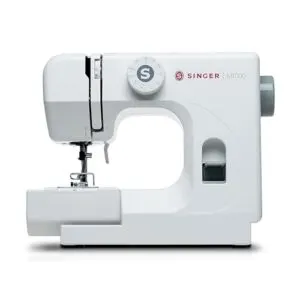 View On Amazon
View On Amazon
When it comes to sewing essentials, the Coats Clark Dual Duty Thread Pack is a versatile choice for both hand and machine sewing. This 2-pack includes one black and one white spool, each offering 400 yards of high-quality polyester thread with a polyester-covered polyester core.
The thread’s durability and flexibility make it suitable for a variety of projects, ensuring your creations are both strong and neat.
- High durability for long-lasting seams
- Suitable for both hand and machine sewing
- Versatile for a range of fabrics and projects
- May not be the best choice for very heavy or very light fabrics
- Limited color options in the 2-pack (black and white only)
- Some users may prefer natural fibers over polyester
Rowenta Access Steam Iron Black
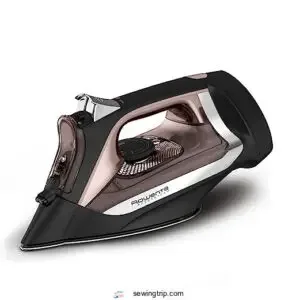
The Rowenta Access Steam Iron Black is a high-performance iron that simplifies garment care with its powerful steam and smart design features. Its stainless steel soleplate is equipped with advanced Microsteam technology, featuring over 300 micro-holes for maximum steam coverage and an exceptional glide.
This iron is designed for durability and long-lasting performance, capable of tackling even the most stubborn creases. Its vertical steaming capability makes it versatile for a range of garments, including suits and delicates.
The iron also includes convenient features like easy refills and a precision tip for hard-to-reach areas, making your ironing tasks easier and more efficient.
- Powerful steam with over 300 micro-holes for exceptional coverage
- Durable stainless steel soleplate for long-lasting performance
- Versatile with vertical steaming capability
- Difficult to gauge water levels
- May sputter steam after use
- Heavier and bulkier due to cord storage
Frequently Asked Questions (FAQs)
How can I prevent my sewing machine from jamming when finishing raw edges with thick fabrics?
To prevent your sewing machine from jamming with thick fabrics, consider the following tips:
Start sewing a bit in from the edge.
Use a fine needle.
Avoid back tacking at the start.
Consider using a leader fabric piece to smoothly transition into your thick fabric.
What are the best hand-stitching techniques for finishing raw edges on delicate fabrics like silk or chiffon?
For finishing delicate fabrics like silk or chiffon by hand, consider using a rolled hem or catch stitch. These techniques offer control and flexibility, ensuring a neat finish without adding bulk or weight to your fabric.
How do I choose the right type of thread for different fabric materials when finishing raw edges without a serger?
Choose the right thread for your fabric by considering its weight and texture.
For lightweight fabrics like silk, use a fine, smooth thread.
For heavier fabrics like denim, opt for a strong, durable thread.
Always test on scraps first.
Conclusion
Perfectly polished projects are now possible without a serger, thanks to these savvy seam-finishing strategies.
You’ve got the know-how to keep your creations from fraying and ensure lasting durability. Whether you wield pinking shears or perfect your zigzag stitch, finishing raw edges of fabric is a breeze.
Embrace these techniques and tools to elevate your sewing, and watch your handiwork hold up with a professional touch that’s sure to impress.

